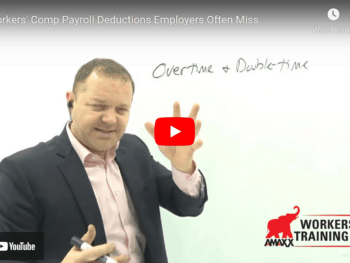It is natural for employers to be overly concerned about serious injury losses. They recognize that the large incurred values will have effect on the experience modification rates set by the state department of insurance. At the same time little attention is paid to the multitude of smaller claims including medical only cases.
Need for Concern:
A claim worth $50,000.00 will garner everyone’s attention. It generally has a better investigation. Medical management will be a top priority. Much effort may go into rehabilitation and vocational programs. Great attention is given to reserving. Benefit and medical payments are audited. Employee compliance is strongly monitored.
Click Link to Access Free PDF Download
“Workers’ Comp Claims Review Checklist: 9 Must-Have, Serious-Impact Elements”
At the same time 10 claims worth $5,000.00 each are given much less attention. The difference between just one claim and ten claims can be significant. The following example will demonstrate this. This assumption is based solely to demonstrate the impact how frequency and severity impacts experience modification calculations and its impact on premium.
Example:
| Claim # | Total Loss | One Year Premium Impact | Three Year Premium Impact |
| Claim 1 | $ 7,500 | $ 3,661 | $ 10,983 |
| Claim 2 | $ 500 | $ 352 | $ 1,056 |
| Claim 3 | $ 9,000 | $ 3,768 | $ 11,304 |
| Claim 4 | $ 3,345 | $ 2,331 | $ 6,993 |
| Claim 5 | $ 4,125 | $ 2,874 | $ 8,622 |
| Total | $ 24,470 | $ 12,986 | $ 38,958 |
| Claim # | Total Loss | One Year Premium Impact | Three Year Premium Impact |
| Claim 6 | $ 110,000 | $ 10,815 | $ 32,445 |
The total three year cost of premium for the largest claim, Claim 6, is $32,445. The total three year cost of premium for the 5 smaller claims, Claims 1-5, is $38,958.
Unit Statistical Filing:
Experience modification rates are determined from the incurred values of all claims in a policy period. These values are reported on Unit Statistical forms to the state insurance department. They are due six months prior to policy renewal.
As an example a policy with renewal effective date of 4/1/2013 must have Unit Statistical reports filed by 10/1/12.
States use statistical data for three policy years to determine the experience modification. This means our example for the 2013 policy also requires unit stat reports for the policies that expired on 4/1/11 and 4/1/10.
The insurance broker or risk manager, should begin a claim review 8/1/12. This review must be based on loss runs for policy periods 2013, 2012, and 2011.
Conclusion:
The frequency of smaller claims can have as much influence, if not more, than large losses or a shock loss. Experience modification rates are based on claim values reported during the past three policy years. A claim review must deal with large or shock losses, but is should also focus on the underlying issues and management of the smaller, more frequent claims. It is important for an employer to understand these points and their impact on workers compensation costs, particularly in a guaranteed cost program.
Author Michael B. Stack, CPA, Principal, Amaxx Risk Solutions, Inc. is an expert in employer communication systems and part of the Amaxx team helping companies reduce their workers compensation costs by 20% to 50%. He is a writer, speaker, and website publisher. www.reduceyourworkerscomp.com. Contact: mstack@reduceyourworkerscomp.com.
©2014 Amaxx Risk Solutions, Inc. All rights reserved under International Copyright Law.
WORK COMP CALCULATOR: http://www.LowerWC.com/calculator.php
MODIFIED DUTY CALCULATOR: http://www.LowerWC.com/transitional-duty-cost-calculator.php
WC GROUP: http://www.linkedin.com/groups?homeNewMember=&gid=1922050/
SUBSCRIBE: Workers Comp Resource Center Newsletter
Do not use this information without independent verification. All state laws vary. You should consult with your insurance broker, attorney, or qualified professional.













